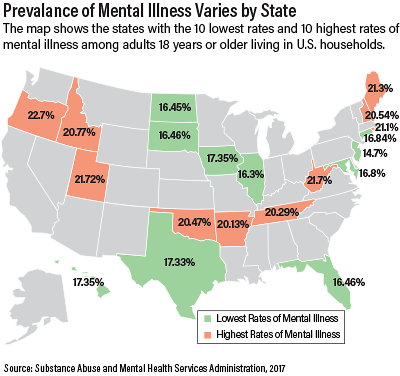Mental illness impacts many households in the United States. In 2014, about 43.6 million adults (18.3 percent of the population) had a mental illness in the previous year, according to a recent report by the Substance Abuse and Mental Health Services Administration (SAMHSA).
The latest SAMHSA’s Center for Behavioral Health Statistics and Quality (CBHSQ) report is based on combined data collected from 2012 to 2014 during the annual National Survey on Drug Use and Health (NSDUH). The 2012-2014 NSDUH data came from 142,000 respondents, 18 years and older, who were asked if they had “any mental illness” (AMI) within the past year. AMI was defined as the presence of any mental, behavioral, or emotional disorder in the past year based on DSM-IV diagnoses.
This specific series of SAMHSA reports surveys only residential households. “It does not include military personnel, people in jails and hospitals, and homeless people not using shelters,” said Phillip Walls, press officer for SAMHSA. “The numbers would be higher if we integrated these groups [into the research], but we have a separate survey for institutions.”
The number of Americans experiencing mental illness in the latest report is slightly lower compared with the previous SAMHSA report, 2010-2012. That report found that 45.9 million American adults, or 20 percent, experienced mental illness at least once annually, though the difference between the two reports is not statistically significant, said Walls.
The SAMHSA study breaks down mental illness rates by state and sub-state regions. New Jersey had the lowest national rates of overall mental illness at 15.83 percent. Other states with comparatively low rates included Illinois (16.36 percent) and North Dakota (16.45 percent). The rates for both Florida and South Dakota were 16.46 percent.
Oregon had the highest rate of adults who experienced mental illness in the past year at 22.72 percent, followed by Utah (21.7 percent), West Virginia (21.7 percent), Maine (21.3 percent), and Rhode Island (21.11 percent).
“Although the prevalence of adults with mental illness ranges widely among the states, it is important to note that there are many people with AMI in every state, which is expected because mental illness is common. … The presence of AMI in every state reinforces that mental illness is a major public health concern in the United States. Factors that potentially contribute to the variation may need further study.”
Across the census regions, estimates of any mental illness were 19 percent in the West, 18.54 in the Midwest, 18.14 in the South, and 17.95 in the Northeast. ■
“State and Sub-State Estimates of Any Mental Illness From the 2012-2014 National Surveys on Drug Use and Health,” can be accessed
here.

